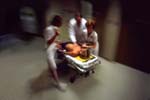High Alert Institute
Have You “Herd” the Word on Secondary Infections?

While many communities may be closing the book on H1N1 at this point in the academic year, administrators and health directors of schools nationwide are preparing for the next wave of illness this influenza season – the wave of secondary infections.
Physicians, virologists, and epidemiologists have known for decades that influenza outbreaks create more than one wave of disease within a community. Be it an incidental outbreak or epidemic or pandemic, the sequence is the same. Initially, the community is a risk for illness caused directly by contracting influenza. And as we all know by now, pandemic strains of influenza can have the greatest impact on the youngest and typically healthiest members of a community. The result of immune systems fighting so hard against influenza diminishes the community’s overall resistance to disease. In many fields of science, this is known as diminishing “herd immunity”.
Herd immunity is the collective resistance to disease within a population. Members within a community (or herd) are protected by measures taken by others in the community to resist disease. This is why vaccination programs are so effective. Individuals receiving vaccines are —once immunity is established—protected from disease and also are less likely to transmit it to others. This benefits not only the vaccinated individual but everyone else in contact with that person. What happens in the wake of significant influenza activity, however, is that the collective immunity of the population is diminished. The immune systems of our youngest and strongest individuals have been taxed and the community as a whole is at greater risk of contracting additional contagious illnesses.
Because the rise of one illness follows in the footsteps of another (the primary illness), this second wave of diseases are known as secondary infections. In the school-aged population, this translates into less resistance to classic childhood illnesses such as whooping cough and croup. Other severe respiratory infections can also take advantage of this opening in the community’s collective defenses. Even optimally immunized children and adults can become better carriers of secondary infections under these circumstances.
The good news for schools and the communities that they serve, though, is that the most valuable tools needed to prepare for the rest of the academic year are already in hand. By using the same preparations and responses developed for H1N1, we will be ready for the wave of secondary infections. Schools have had the opportunity to fine tune their outbreak notification systems, distributing information with just one call, to parents and faculty, as well as public health officials. Policies and procedures outlining the criteria for children to be sent home from school or when they are able to return to class are well-established. Continuing the same well-rehearsed hygiene practices, such as hand washing and cleaning of hard surfaces between uses, are effective ways to reduce transmission of secondary illnesses. And, as some schools have found, rotating the teachers, rather than students, between classes can decrease the exchange of germs by reducing the crowding of hallways and creating a more steady state of social distancing throughout the school day.
Just as importantly, there is good news as well for parents and caregivers. Families should not have to prepare for this wave of illness in their communities any differently than they prepared for H1N1. Keeping an ill child home from school or away from community gatherings, and not returning until the recommended public health criteria are met, will reduce the risk of secondary infection for the entire community. Also, remembering to keep your emergency contact information and a back-up caregiver’s information current with your child’s school is a vital link in this process.
In short, during these final weeks of the H1N1 pandemic and final months of the 2009/2010 cold and flu season, secondary illnesses will be looking for an open door into our communities. The key to a successful academic year for all of our students will be to maintain our current defenses against the spread of disease and continue our practices of a healthy return to the classroom.
High Alert Institute
4800 Ben Hill Trail
Lake Wales, FL 33898
Office: 863.696.8090
FAX: 407.434.0804
EIN: 27-5078437
Info@HighAlertInstitute.org
Privacy Policy
Cookie Policy
Terms of Use
Disclaimers
Get Your Data
Shipping Policy
Message Us
Transparency
Registrations
Do Not Sell Info
Return Policy
A COPY OF THE OFFICIAL REGISTRATION AND FINANCIAL INFORMATION MAY BE OBTAINED FROM THE DIVISION OF CONSUMER SERVICES BY CALLING TOLL-FREE, WITHIN THE STATE, 1-800-435-7352 (800-HELP-FLA), OR VISITING www.FloridaConsumerHelp.com. REGISTRATION DOES NOT IMPLY ENDORSEMENT, APPROVAL, OR RECOMMENDATION BY THE STATE. Florida Registration #CH68959
REGISTRATION WITH A STATE AGENCY DOES NOT CONSTITUTE OR IMPLY ENDORSEMENT, APPROVAL OR RECOMMENDATION BY THAT STATE.










